Thinking Caps... Page 2
Real capacitors – like real politicians – do not behave perfectly, and it is in the ways they fall short that much of the preoccupation with them as influencers of sound quality resides. The first issue is that no practical capacitor serves up pure capacitance: it also has finite inductance and resistance. So while the capacitor in a circuit diagram will typically appear as one of the symbols in Fig 5 (all of which make visual reference to two separated plates), the real capacitor will be a circuit like that shown in Fig 6 – and even this is simplified. The resistor labelled ESR (equivalent series resistance) may not be constant but frequency-dependent. With electrolytic capacitors, ESR usually decreases with frequency.
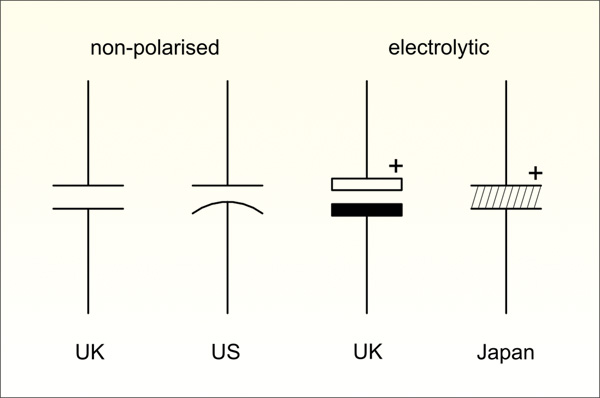
Network News
One consequence of capacitors having a finite inductance (ESL, or equivalent series inductance in Fig 6) is that they are inherently resonant electrically. If a capacitor's impedance is plotted against frequency, it doesn't – as it ideally should – continue to reduce as frequency increases. As Fig 7 illustrates, the impedance reaches a minimum (equivalent to the ESR value) at the resonance frequency and then, as frequency increases, it also begins to rise again as a result of ESL.
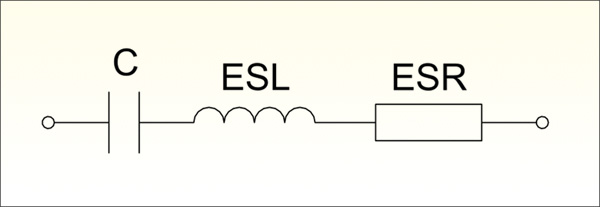
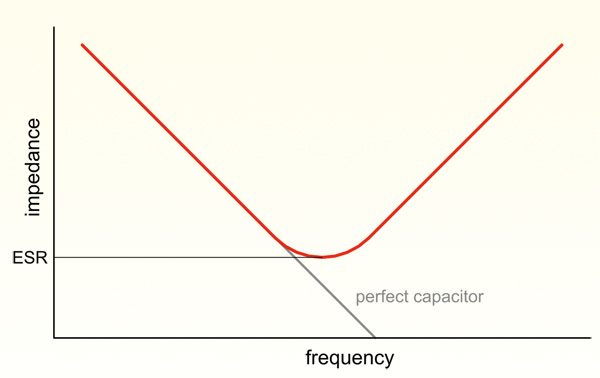
This behaviour is of particular importance where capacitors are deployed to reduce susceptibility to radio frequency interference, but there are amplifier designers who believe that in-band and out-of-band electrical resonances are one reason why amplifiers sound different.
Large electrolytic capacitors typically have electrical resonance frequencies within the audio band. Smaller capacitors have electrical resonance frequencies that may exceed 1MHz. To increase the electrical resonance frequency for a given capacitance it is necessary to reduce ESL, the series inductance.
Various methods have been contrived to achieve this in electrolytic capacitors, where the problem is most acute. DNM's T-Network capacitors, for instance, use a T-pattern of foil connections to reduce inductance such that resonance frequency is more than doubled compared to a standard design (28kHz to 75kHz in an example given by DNM on its website).
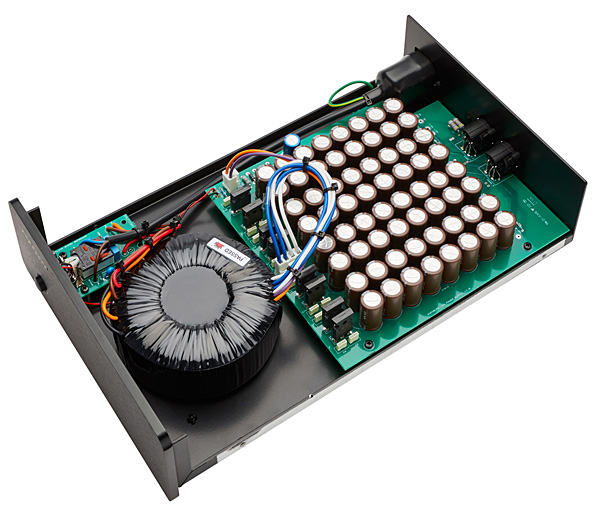
ESR has the potentially beneficial effect of damping a capacitor's electrical resonance but, unlike inductance or capacitance, resistance generates heat when a current passes through it. In big reservoir capacitors, where currents through the capacitor are high, this internal heating effect sets a limit on safe operating conditions. That said, however, electrolytic capacitors work best when warm.
Audiophile Faves
Much of the attention paid to capacitors in the late 1970s and early 1980s focused on the behaviour of dielectrics, and those concerns were carried over to cables because they too use insulating materials and behave, in part, like capacitors. Thus PVC cable sheathing came to be vilified, with PTFE (aka Teflon) and polyethylene preferred. Two factors claimed most attention: dissipation factor (DF) and dielectric absorption (DF). DF relates to the capacitor circuit diagram of Fig 6 and is inversely proportional to the Q (sharpness) of the electric resonance depicted in Fig 7. DA is a measure of how reluctant a capacitor is to surrender charge that it has stored and is sometimes referred to as 'capacitor memory'.
Table 1 [see below] – which is derived from part two of the classic article 'Picking Capacitors' by Walter Jung and Richard Marsh, published in the February and March 1980 issues of Audio – shows how DF and DA compare for various dielectrics and explains why polypropylene, polystyrene and PTFE capacitors became audiophile favourites.
It also became increasingly common to see reservoir capacitors fitted with much smaller film capacitors in parallel, in an attempt to improve the electrolytics' performance. A high-voltage film capacitor is shown in Fig 8.
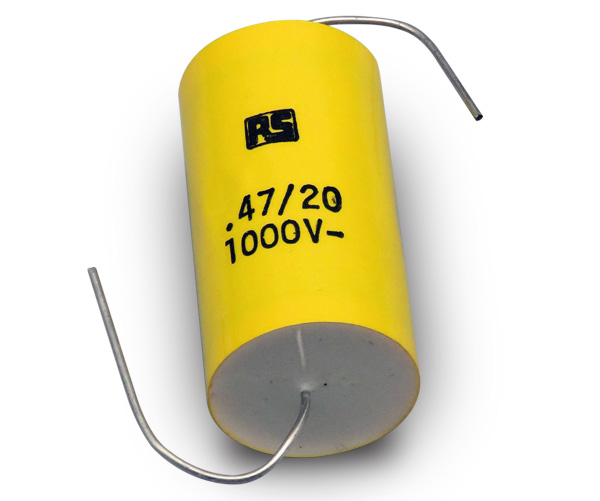
Microphonics
It's perhaps no surprise that valve (tube) equipment is sensitive to vibration. Within the evacuated glass envelope of a valve are thin metal electrodes whose spacing affects the valve's operation. So shake a valve vigorously enough and that shaking will be reflected in its electrical output, an effect known as microphonics because the valve is behaving like a crude microphone.
Solid-state electronics are less obviously susceptible to this effect but – to take an extreme example – the designers of early engine management systems in racing cars soon learnt not to bolt the electronics to the engine, or to incorporate sufficient compliant isolation if they did, otherwise high levels of engine vibration could disturb its operation. The levels of vibration experienced by hi-fi equipment in normal use are very much lower, of course, but some manufacturers – Naim Audio is a prime example of this – still go to considerable lengths to minimise the potential effect it has on their products.
Because a capacitor's ability to store charge – its capacitance – is proportional to the area of the plates and inversely proportional to the distance between them, the 'plates' are more normally thin foils with thin layers of dielectric inbetween. In metallised capacitors the plates are thinner still, and are formed by vapour deposition of aluminium on to a plastic film dielectric. The effect of this is to render capacitors inherently prone to microphonics because physical distortion caused by vibration can change plate spacing, and thereby the capacitance value.

So the physical properties of the materials from which a capacitor is built can be as important as the electrical properties. Some capacitors even use dielectrics that are piezoelectric (ie, they generate a voltage if physically distorted), which makes vibration sensitivity still worse – a particular problem with some types of multilayer ceramic capacitor.
And external vibration isn't necessary for capacitors to suffer from vibration effects: forces generated by voltages and currents within the capacitor itself can excite mechanical resonances. Some capacitors can even be heard to emit sound when a signal is passed through them because of this effect. Here, in a passive loudspeaker crossover – where vibration levels, voltages and currents are all high – there's a perfect storm of factors that make capacitor selection particularly critical.
Key Decisions
While a lot of lip service has been paid over the years to the issue of capacitor microphonics and signal-induced mechanical resonances, there has been relatively little research on the subject. Little published research, at any rate. But what does exist certainly supports the notion that this is a significant effect with potential consequences for sound quality.
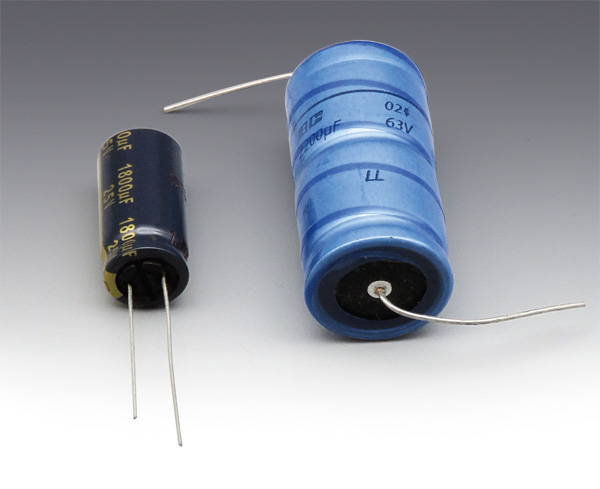
Likewise, there are circumstances when capacitors can give rise to non-trivial levels of nonlinear (ie, harmonic and intermodulation) distortion. Understanding how this occurs and where in a given circuit the effect will be most significant allows designers to focus their efforts on key parts of the circuit when selecting components – areas where it will be of most benefit.
Readers who'd like a list of references for further reading on capacitors in audio applications can access a PDF from my website: www.audiosignal.co.uk/resindex.html



























































